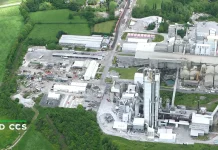Digital materials passports that detail a building’s components could hold the key to moving away from construction’s throwaway culture and towards a circular economy, says Andrew Mitchell, operations director for sustainability at Mace
Currently responsible for over 40% of global carbon emissions, it’s no secret that cleaning up the construction and operation of our buildings will be vital if we want to successfully turn the tide on climate change of global material waste coming from the construction industry.
One way to do this would be to extend the life of materials and components used in buildings – thereby dramatically reducing the near-constant demand for raw materials and the subsequent carbon-intensive manufacturing. But how do we do this – and, crucially, where should the circular process start?
Embracing a circular economy
To move us away from a throwaway culture, we need to embrace what is known as a circular economy, one that prioritises the reuse and repurposing of materials. Within the construction industry, this translates to maximising the life of existing buildings and reusing building components that have not yet reached the end of their lifespan.
This is not just about preserving valuable materials but also reducing the embodied carbon of buildings by eliminating unnecessary consumption of viable raw resources.
Mace’s recently published report, Closing the Circle, outlines that if we are going to combat climate change then we need to take action as soon as possible – starting in the construction phase.
What can we do when erecting new buildings to ensure that the component parts are most likely to be used until they are no longer fit?
Gain control of data
The first critical step is to gain control of the data. Without fully understanding what components are in a building, and how long they have been in-situ, it is hard to know what materials can be reused.
This is where digital catalogues, or material passports, come in.
Material passports are served as digital documents containing a building’s components, characteristics and materials. They provide a reliable source of information regarding their potential value for current use, future recovery and reuse.
By recording details of the components used within the construction of a development, these digital passports make it significantly easier to harvest materials for future reuse.
This provides a perfect solution for reducing waste at the end of life of the building, through advanced design techniques and increased materials data visibility.
While the concept has existed for some time, practical implementation in the construction industry has been elusive until now.
Making materials passports a reality
As the principal contractor for the ambitious 12-storey Edenica project on Fetter Lane, we knew this was not just another addition to the skyline but a bold step towards a sustainable future and a more responsible construction sector.
The scheme itself incorporates a range of sustainability features, from mixed-mode ventilation to water recycling and underfloor air systems.
But what truly sets it apart is its pioneering approach as a “storage bank”, leveraging the concept of materials passports and redefining how we construct and deconstruct our urban spaces.
Indeed, this is the first development in the City of London to be using materials passports – and we are honoured to be leading its construction.
Barriers to adoption
Digital cataloguing of components certainly could be the next big thing for responsible construction but to truly harness the potential of this data-led innovation, there will need to be a much wider uptake.
The more transparency around the materials we can reclaim from expired buildings, the more scope there will be for the industry to create a market to utilise materials that are fit for reuse.
The data storage structure needs to be defined to allow access and editing control for all, throughout the life of the building. It cannot be hidden within specialist tools or behind licensing agreements (for example, within the BIM model).
It will need to be updated as building elements are renewed.
The data needs to be exchangeable as and when building owners/tenants change over the years.
To date, practical implementation of materials passports at scale has been lacking within the construction industry.
With the built environment globally accounting for 50% of all material waste, there is an urgent need to take collective control of materials stocks.
Opening borders for responsible business
The circular economy revolves around the idea of taking waste from one project and transforming it into a valuable resource for another. This innovative approach is becoming increasingly recognised and celebrated for its potential to significantly reduce the environmental footprint of the built environment.
By using materials passports, we can empower building owners, occupants and construction teams and bring about confidence to embrace reuse. And, as we continue to push for longer lifespans of buildings, we should also be considering how to revive parts of buildings which are at their end of life.
If more developers and construction firms take the materials passport approach, there is tangible potential to significantly reduce carbon emissions, reduce waste and drive forward the industry’s efforts to provide a sustainable circular economy across the built environment.
Andrew Mitchell
Operations director for sustainability
Mace














